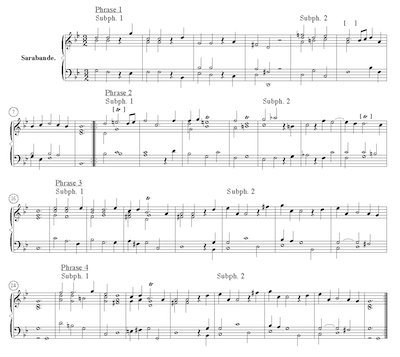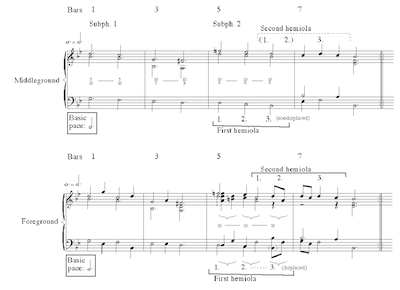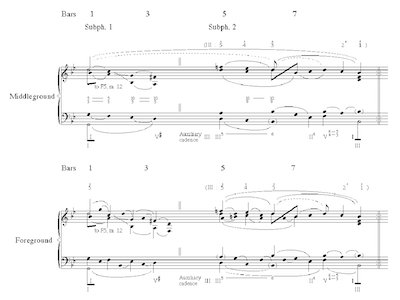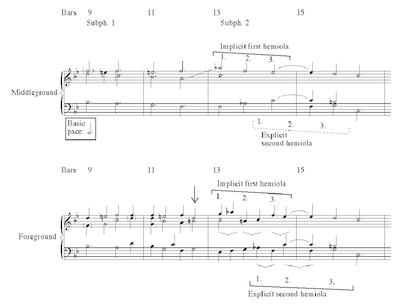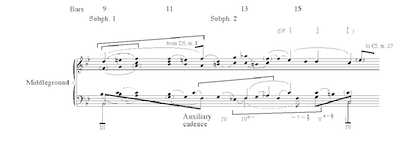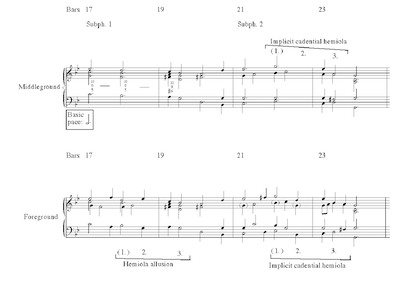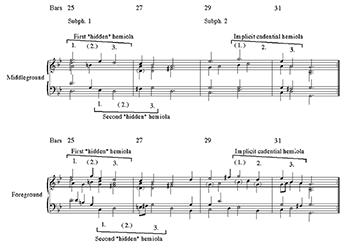Handel, the Sarabande, and Levels of Genre: A Reply to David Schulenberg
Channan Willner
REFERENCE: http://www.mtosmt.org/issues/mto.96.2.5/mto.96.2.5.schulenberg.html
REFERENCE: http://www.mtosmt.org/issues/mto.96.2.3/mto.96.2.3.willner.html
KEYWORDS: Schulenberg, Willner, Handel, Mozart, hemiola, sarabande, narrative, semiotics
ABSTRACT: In his commentary on my article, “More on Handel and the Hemiola,” David Schulenberg favors a historically informed, intertextual approach to the analysis of relatively unfamiliar works, one that hinges on the listener’s knowledge of generically comparable works. By way of reply I combine recent semiotic theory with a more traditional Schenkerian approach to show how the narrative articulation of generic topics shapes the way we hear, interpret, and re-create such works, and how such articulation responds to tensions that are inherent in stylistic and generic norms.
Copyright © 1996 Society for Music Theory
[1] In a famous letter to his father concerning the premiere of the fortepiano concertos, K. 413, 414, and 415, Wolfgang Amadeus Mozart wrote:
These concertos are a happy medium between what is too easy and too difficult; they are very brilliant, pleasing to the ear, and natural, without being vapid. There are passages here and there from which the connoisseurs alone can derive satisfaction; but these passages are written in such a way that the less learned cannot fail to be pleased, though without knowing why.(1)
Mozart evidently had a wide range of listeners in mind, from the musically trained connoisseur and amateur to the music lover who could neither conceptualize nor verbalize the attractions of a piece. Implicit in Mozart’s remark, “the less learned cannot fail to be pleased, though without knowing why,” is Mozart’s confidence in the appeal to the listener of the special elements in each piece; Mozart’s modus operandi is to interweave the remarkable with the more explicitly mundane, and to work out the tensions between them in the course of the piece. A look at the listener’s and the scholar’s response to such tensions—oppositions between marked and unmarked compositional resources, as Robert Hatten calls them in his book, Musical Meaning in Beethoven(2)—is the focus of my reply to David Schulenberg’s response (Music Theory Online 2.5 [1996]) to my article, “More on Handel and the Hemiola: Overlapping Hemiolas” (Music Theory Online 2.3 [1996]).
[2] Referring to my analytical remarks concerning the hemiolas in the Sarabande from Handel’s Suite in G minor, HWV 432, Schulenberg expresses his unease at my “avoiding questions about the work’s historical context and its relationships to other works of a similar type” (paragraph 1); because I did not relate topical features of the G-minor Sarabande, such as its conspicuously accented second beats, to those found in other early eighteenth century sarabandes in general and to other Handelian sarabandes in particular, I approached the G-minor Sarabande as a fixed object, assigning unwarranted significance to—and perhaps misinterpreting—several passages which I felt were decidedly hemiolic (paragraphs 6–9). My principal aim in writing about overlapping hemiolas—a succession of two hemiolas that is collapsed into three measures in each voice in which it appears—was in fact to offer a detailed theoretical account of an important phenomenon not previously described in the scholarly literature.(3) Even though I tried to place my remarks within the wider compositional context of each piece, I made no attempt to offer a broader analytical perspective, let alone a historical or intertextual one. To have done so would have entailed an extended discussion of each composition’s topical and generic features, features complex enough to warrant a separate full-length study. In the present reply I plan to offer just such a study, of the G-minor Sarabande, and to examine the relation of its topical features to its long-span rhetoric. I hope to show how the Sarabande can be approached analytically as a unique work of art despite its similarity to other sarabandes, and to demonstrate that the flexibility required by such an approach precludes treatment of the piece as a “fixed or ideal (real) object” (Schulenberg, paragraph 3).
[3] The distinction Hatten draws between marked and unmarked materials is most helpful when we attempt to define what is special about the Sarabande. A stretch of the composition is marked when it stands out from among the surrounding passages in some way, especially in its topical, stylistic, or thematic design. A passage remains unmarked if it fits in with the norms the piece has had a chance to establish.(4) These notions are essential to gauging the first-time listener’s participation because the listener will usually expect a good deal of the familiar in any potential addition to his or her listening repertoire, along with the novel and the unfamiliar.(5) They can also be applied to different types of structure at various levels, greatly facilitating the composition’s placement in a wider stylistic and generic context. Among the differences between Schulenberg’s outlook and mine is a divergence in approach to markedness, apparent even though Schulenberg doesn’t use any semiotic terminology. The hemiolic passages from the Sarabande and from the Musette from Handel’s Concerto Grosso in G minor, op. 6, no. 6, that I view as marked emerge as both nonhemiolic and unmarked in Schulenberg’s response (paragraphs 7–11).
[4] The appearance of hemiolas is, I believe, usually a marked event because the small-scale, temporary metrical hierarchy the hemiolas suggest conflicts with the prevailing metrical grid.(6) Furthermore, the surface adjustments that create hemiolas—changes in grouping, pace, and thematic design—are often emphatically marked as well. But even when hemiolic passages appear to replicate unmarked formulaic cliches that recur in dozens of pieces they may nonetheless be transformed by the tensions of the composition’s unfolding narratives into decidedly marked progressions. The major attribute of marked passages is not necessarily their novelty as such but rather the narrative friction they generate against earlier progressions that the compositional process has left unmarked.(7) It is to the reification of such friction that the listener intuitively responds in assaying the challenge of a new piece.
[5] Both at the surface and at deeper levels of generic structure the opposition between marked and unmarked material reflects the narrative schemes that (in tandem with tonal and durational structure) hold tonal compositions together. In retracing these schemes through the foreground and across the generic form of the piece, it is often helpful to specify the generic level of the issue in question. I employ Hatten’s stylistic level to refer to surface issues, and his strategic level to denote large-scale matters, such as the rhetorical ordering of groups and sections.(8) At the very foreground, I find it most helpful to employ the notion of topic (made familiar through the work of Ratner, Agawu, and others) to designate the idioms most closely associated with the genre under discussion. Topics in Handel’s G-minor Sarabande include the characteristic pairs of repeated notes on the first and second beats of many measures, the preponderance of durational accents on many second beats, the use of characteristic chordal and intervallic textures in thematic areas, and (on a somewhat larger scale) the predominantly stepwise underlying progressions as well as the uniform division into eight-bar phrases and four-bar subphrases. Although the hemiola is not a sarabande topic as such, it appears in sarabandes rather more frequently than Schulenberg intimates (paragraph 8), as a glance through the literature quickly reveals.(9) In their own home genre, topical passages are (at least at the outset) essentially unmarked since they are familiar to the listener who has heard many exemplars of the genre. But when the same topical passages make guest appearances in other genres, as they often do, they acquire a decidedly marked quality. In Handel’s G-minor Sarabande, topical passages appear only on their own turf and remain unmarked until the Sarabande’s narrative scheme transforms them into marked passages, in the later stages of the piece. Such transformation may be regarded as thematic, achieved through a process of thematization, when it supports the narrative discourse at the strategic level.(10)
[6] Among the most important issues that need to be reexamined here is the extent of the listener’s intuitively intertextual response to the presentation of early eighteenth-century genres, a central concern of Schulenberg’s. I should like to defer detailed consideration of this issue to the closing paragraphs of my reply because it is dependent on the outcome of a tonal, durational, and narrative analysis of Handel’s Sarabande, and on a reappraisal of its hemiolas.
Example 1. Handel, Suite in G minor HWV 432, Sarabande
(click to enlarge)
Example 2. Handel, Sarabande, mm. 1–8, Durational Reductions
(click to enlarge)
Example 3. Handel, Sarabande, mm. 1–8, Tonal Reduction
(click to enlarge)
[7] Handel’s Sarabande is reproduced in its entirety in Example 1. It divides into four phrases of eight bars, and each phrase divides further into two subphrases of four bars. The opening subphrase, bars 1–4, at once lays out the Sarabande’s gallery of topical, unmarked idioms. The durational accents on the second beat in each measure are underlined in bars 1 and 3 by dissonant passing tones in the bass; the essentially stepwise movement of the outer voices at the level of the measure, which outlines parallel fifths in bars 1–2 and parallel tenths in bars 3–4, is broken up discreetly on the last quarter note of bars 1–3 by ancillary falling fifths in first inversion or root position. The only marked features of this subphrase are the upper-voice leaps that introduce the repeated-note figures at the turn of bars 2 and 3, and the surprising disjunction between the groups of parallel fifths and tenths at bar 3; these portend more strongly marked disruption ahead.
[8] The structural parameter that mediates between the presentation of topical material in bars 1–4 and its thematization later on is what I call the basic pace, the largely stepwise movement of the outer voices in their unembellished, unexpanded, and normalized state.(11) In the early eighteenth-century repertoire, the basic pace shines clearly through the textures of the foreground except when it is hidden by the temporary prominence of subservient, faster paces; the rate of its progress differs from meter to meter, and it frequently undergoes expansion and contraction to slower and faster motion. From time to time it is modified by arpeggiation and by the retention or repetition of essential tones.(12) The upper level of the durational reduction of bars 1–8 in Example 2 shows the basic pace in bars 1–4 as a series of dotted half notes; observe how the ancillary voice leading at the close of bars 1, 2, and 3 is phased out at the upper level to reveal its one-to-the-bar movement.
[9] The second subphrase, bars 5–8, introduces an abundance of tonal
and durational intensifications, beginning with the contradiction of
[10] As John Rothgeb perceptively pointed out on mto-talk (April 5,
1996), the third tenth—the third hemiolic beat—of the first hemiola
is not entirely usurped by the entrance of the second hemiola.
Rather, it is displaced, from the second to the third beat of bar 6,
where D5—![]()
![]()
[11] My reasons for reading the second hemiola in the foreground are
both durational and tonal. Durationally, bars 6 and 7 divide into
three distinct and equal stretches: A whole note occupies the first
two beats of bar 6 and another whole note (in the form of the dominant
tonicizing the key of ![]()
![]()
Example 4. Handel, Sarabande, mm. 9–16, Durational Reductions
(click to enlarge)
Example 5. Handel, Sarabande, mm. 9-16, Tonal Reduction
(click to enlarge)
[12] In bars 9–12, the first subphrase of the Sarabande’s second
phrase, the topically familiar setting of bars 1–4 returns. Although
repeated notes, as such, appear only in the bass of bar 9, chordal
accents on each second beat are once again highly conspicuous,
supported by dissonant intervallic sonorities (including prominent
augmented fourths) in bars 9 and 11, and by a surprising G-major chord
in bar 12 that seems to announce the following subphrase prematurely,
entering a mere one beat after the key of F major has been locally
tonicized. As the bilevel durational reduction
of bars 9–16 in
Example 4 demonstrates, the one-bar basic pace prevails throughout the
subphrase and describes an underlying descent of a fourth from
[13] The second subphrase, bars 13–16, again shows dramatic markedness and offers contrasts that, despite some attenuation, parallel those in bars 5–8. These contrasts are underlined by the quarter-note rests in bars 13 and 14, which derive quite explicitly from the rests in bars 1–3 but operate in a very different way.(16) In bars 1–3, the rests stand for the entrance of ancillary chords and displace each chord to the last quarter note of the measure (see the lower level of Example 2); both the rests and the chords enter well away from the steps of the basic pace, which treads at the downbeat. In bars 13 and 14, the rests stand for (and delay the appearance of) appoggiatura-like chords that embellish a two-measure, essentially hemiolic bass arpeggiation of an F-minor chord. The durational reductions in Example 4 show both how the rests displace the “appoggiatura” chords by a quarter note and how the combined time-span of each rest-and-chord pair in turn postpones the arrival of each arpeggio tone by a half note.(17) Here the basic pace temporarily abandons its stepwise progress in order to outline the three hemiolic steps of the F-minor arpeggiation; as in bars 5–6, it accelerates to movement in whole notes (half notes in the upper level of Example 4). The first of the three steps, in bar 13, is delayed by the half-note “appoggiatura” chord at the downbeat; the second and the third steps are delayed by the combined rest-and-chord pairs, and consequently appear, at the surface, in bar 14. From the perspective of the foreground, then, the first of the two overlapping hemiolas in bars 13–15 is expressed, implicitly, by the rests in bars 13 and 14 (see my article, paragraph 10); from the perspective of the middleground, it is expressed by the normalized F-minor arpeggiation. Although the progression in bars 13 and 14, as such, is hardly unusual and the texture of the two measures remains very simple, its underlying complexity and circumstantial rhythmic dissonance (to which I believe our listener, like Mozart’s “less learned” auditor, will intuitively respond) certainly sets it off for markedness.
[14] The displaced C-minor chord on the last beat of bar 14 not only brings the first, implicit hemiola to a close but also signals the emergence of the second, more explicit hemiola. Like its counterpart in bars 6–7, the second hemiola is not structurally supported by the basic pace; but unlike its counterpart, it is not cued at the outset by a change in the design, so that one becomes aware of it only when it is already in progress. If the hemiolas in bars 5–7 are rhetorically disruptive, those in bars 13–15 can be viewed as reticent, but their impact is equally substantial. (The basic pace again accelerates cadentially in bar 15, just as it did in bar 7, and the second hemiola again resides at a level closer to the surface than the first. As the reductions show, it too disappears at the higher level, while the hidden first hemiola stays put.)
[15] We are now in a position to go back and examine the significance
of the G-major chord on the second beat of bar 12. As a locally
applied dominant to the C-minor sixth chord that enters in bar 13, the
G-major chord resides within the time-span of the inherently measure-long F-major chord of bar 12 (see Example 4). The disruption it
occasions is due both to its early contradiction of F (through the
alteration of
[16] A casual audition of the third phrase, bars 17–24, would seem to indicate that its two constituent subphrases, bars 17–20 and 21–24, relate to each other in much the same way as did the subphrases in the two earlier phrases. Not only do bars 17–20 revert to the potentially unmarked rhythms, figurations, and one-bar pace of the typical Sarabande opening; their almost exclusively stepwise design recalls that of the typical Sarabande rather more closely than does the more disjunct contour of bars 1–4. The effect of this subphrase seems to be that of reculer pour mieux sauter—a lessening of tension in preparation for more developmental events yet to evolve.(19) But appearances in this instance are highly deceptive. The resumption of sarabande topics dispenses with the characteristic rests of bars 1–4 and substitutes full chordal texture for the lean three-voice setting of the opening measures, and it shows a sudden temporary acceleration in the basic pace (bar 19) to movement in half and whole notes (quarter notes and half notes in the durational reduction in Example 6). Furthermore, it enters half a step higher than did the opening of the Sarabande (a move whose significance will become apparent later on). These changes suggest that the subphrase is more developmental than it seems to be—that its Sarabande topics are in the process of becoming marked and thematized.(20)
Example 6. Handel, Sarabande, mm. 17–24, Durational Reductions
(click to enlarge)
Example 7. Handel, Sarabande, mm. 16–32, Tonal Reduction
(click to enlarge)
Example 8. Handel, Sarabande, mm. 25–32, Durational Reductions
(click to enlarge)
[17] The second subphrase assumes a similarly deceptive appearance.
Its displaced recollection of bars 13–14 (discussed below) and of bars
1–3 (Schulenberg, paragraph 14), and its cadentially intensified bass
movement, which straddles the bar line at the turn of bar 23, allow
the subphrase to feign the marked developmental quality for which the
preceding subphrase seemed to prepare. But its basic pace accelerates
only at the cadence, in bar 23 (see Example 6), allowing the upper
voices—for the first time in a second subphrase—to make full use in
each measure of the Sarabande’s second-beat accents; it offers only
hemiolic reminiscences, not fully realized hemiolas (see my article,
paragraph 12); and, in contrast to the active arpeggiation and
extension of F minor in bars 13–15, its bass line suggests a
stationary extension of a ![]()
[18] Appearances in the third phrase are deceptive in yet another respect. The tonal reduction in Example 7 indicates that the phrase closes with a bass ascent to G, the upper fifth of the subdominant, C. The tonicization of G minor in bar 24 does not really signal a return to the tonic (which is completely regained only at the end of the piece); it provides a contrapuntal milieu for the startling appearance of the minor dominant at the beginning of the fourth phrase, in bar 25 (see Example 7), a chord that recalls the D-minor sonority of bar 5.
[19] The two subphrases of the fourth phrase—bars 25–28 and 29–32—
bring to fruition the twist suggested in the third phrase. Although
bars 25–28 again offer the potentially unmarked Sarabande topics of
bars 1–4, and bars 29–32 repeat bars 21–24 (an instance of a petite
reprise, as Schulenberg correctly observes, though one that occurs
under altered tonal circumstances), the relationship between the two
subphrases now changes entirely. The Sarabande
topics enter over the
harmonically unexpected minor dominant, in full chordal texture, and
in a still higher register—a step higher than the topics in bars
17ff., and two steps higher than those in bars 1–4—and the basic pace
undergoes sustained acceleration, to an alternation of half notes and
whole notes in both bars 26 and 27 (quarter notes and half notes in
the upper level of the durational reduction in Example 8).(21)
Together, these changes generate the explicitly marked quality that
bars 17–20 did not yet possess; the Sarabande topics have now become
fully thematized. Note how the acceleration in
bars 26–27 coincides
with the contrapuntal deployment of chromatically inflected dominant
and subdominant chords, and how bars 25–27 suggest hidden, overlapping
hemiolas (as I pointed out in my article, paragraph 12 and Example
5).(22) Particularly striking is the
recollection of bar 5—the
Sarabande’s thematic turning point—at the downbeat of bar 25. The
very same chord that announced the thematization of the second
subphrase now proclaims that of the first. When we compare the
tension accumulated in bars 25–28 to the sense of peroration
occasioned by the repetition in bars 29–32, we realize how unmarked
the contents of the second subphrase have become.
They simply
reinforce the harmonic stasis of the ![]()
[20] Looking back now at the relations among the subphrases throughout the Sarabande, we can retrace in more organized fashion the narrative implications of the gradual reversal in their relationship. In transferring the realization of markedness and thematization a few steps at a time from the second subphrase to the first, and in shifting the strategic emphasis from the thematization of hemiolic progressions to the thematization of Sarabande rhythms and topics, Handel recounts a narrative plot that is based on the most common features of the Sarabande’s generic topics. The reversal in markedness represents Handel’s way of thematizing the Sarabande’s generic division into eight-bar phrases and four-bar subphrases. Even when Handel moves away from Sarabande topics through the introduction of atopical hemiolas at the stylistic level, he does so for the sake of thematizing the topics at the higher strategic level, through the articulation of sharp contrasts between the subphrases.(24) Thus the acceleration of the basic pace, which plays a major role in each thematization, makes repeated use of the Sarabande’s second-beat emphases, whose tonal and durational activation (as in bars 5 or 13) allows each acceleration to get underway; chromatic shifts, similarly thematic, occur either at the beginning of subphrases, realizing their markedness (bars 5, 25), or on the second beat (bars 12, 26). If we remain sensitive to both the narrative and the intertextual significance of this ongoing give and take between topic and markedness we shall, I think, avoid the danger of treating the Sarabande as a fixed object.
[21] Adopting a stance rather narrower than the wide stylistic and strategic vantage markedness theory requires, several scholars have recently suggested that genre is the one element of the design (unlike, say, style or structure) in which the listener participates directly through his or her familiarity with other generic exemplars and through his or her expectation that, up to a point, any new piece will in many ways resemble a substantial body of familiar pieces.(25) In a highly influential study, Jeffrey Kallberg has even likened genre to a contract between the composer and the listener; adherence to the contract is the basis for the composer’s discourse, but the contract is liable to be broken at any time.(26) A composition’s identity might thus be determined by departures from generic norms at the stylistic level occasioned by external plots or incentives at the strategic level that do not necessarily relate to the foreground in a particularly close way. One problem with applying such a view (along with a constricted view of the listener’s competence or participation) to early eighteenth-century music is that generic norms and prescriptions at the strategic level are loosely defined in this repertoire, while stylistic topics (such as the sarabande topics we’ve been dealing with) are set quite firmly in place.(27) An analytical account of high-Baroque genres should take into account the close links that exist between topics and topic-related events at the stylistic level and the narrative schemes that organize them, through markedness and thematization, at the strategic level. The topical norms of each genre, unmarked though they may be, contain elements of potential tension whose realization and resolution call for the intervention of a narrative scheme.(28)
[22] The organization and ordering of generic topics by large-scale narrative or rhetorical strategies is hardly a new idea; it forms the basis of important recent works dealing with late eighteenth- and early nineteenth-century repertoires by Elaine Sisman, Scott Burnham, and others.(29) The difficulty in reconstructing the narrative strategies of early eighteenth-century music resides in the brevity, small scale, and surface uniformity of its constituent pieces, which often seem to be rhetorically cryptic. I believe it is nonetheless essential for both analyst and listener to attempt such reconstructions if they are to experience the essence of this repertoire. This, in fact, was the unstated assumption of my article—not verbalized as such, but clearly implied by my comments on the larger course of events in the Sarabande (paragraphs 10–12) and in my remarks on the introduction and dissipation of hemiolic tension in the Musette from the G-minor Concerto Grosso, op. 6, no. 6 (paragraphs 17–18).(30)
[23] It is of course by no means certain that the listener’s plot will coincide with the composer’s or the analyst’s, or with the performer’s, for that matter.(31) The analyst might attempt to reconstruct what he or she believes is the composer’s own strategy or plot, with the hope that the results, backed up by a sound scholarly apparatus, will gain some sort of validity and acceptance. The listener, possessing few of the analyst’s sophisticated tools, might by contrast try to construct an ad hoc, homemade scheme. But the process involved will be fundamentally the same. Thus even if in bars 5–7 of Handel’s G-minor Sarabande “virtually every detail of its rhythm, melody, and harmony is a formula that can be found in other examples of this same genre,” and even if (unlikely as it seems to me) “many such listeners may not even be able to recall, during a performance, whether a ‘reference’ at, say, measure 25, is to a previous point in the same piece or to a similar passage in another one” (Schulenberg, paragraph 12), I would maintain that both analyst and listener will approach such passages first and foremost as unique moments in a unique work of art that tells a unique story. Their interpretations will depend less on their capacity to recognize the intertextual roots of such passages as they will depend on their capacity to interpret the unique use to which these roots are put in relation to what they have just heard and in relation to what they are about to hear. For the listener as well as the analyst, making the acquaintance of Handel’s G-minor Sarabande is therefore apt to be an active, creative experience; neither is likely to take the composer’s word on faith.
Channan Willner
The New York Public Library for the Performing Arts
Music Division
40 Lincoln Center Plaza
New York, NY 10023-7498
cwillner@nypl.org
Footnotes
1. The Letters of Mozart and His Family, trans. and
ed. by Emily
Anderson (London: The Macmillan Press, 1985), page 833. This passage is
discussed from a similar perspective by Leonard Ratner in Classic
Music: Expression, Form, and Style (New York: Schirmer Books, 1980),
page 3. For more on Mozart and his listeners vis-a-vis his letters see
V. Kofi Agawu, Playing with Signs: A Semiotic Interpretation of
Classic Music (Princeton: Princeton University Press, 1991), pages
3–4.
Return to text
2. Robert S. Hatten, Musical Meaning in Beethoven:
Markedness,
Correlation, and Interpretation (Bloomington and Indianapolis:
Indiana University Press, 1994). The role hemiolas play in
diversifying the durational regularity of dance topics at various
levels was explored by Joseph C. Kraus in his paper, “Viennese
Classicism, Russian Classicism: Mozart, Tchaikovsky, and the Use of
Convention,” presented at the conference, “Austria 996–1996: Music in
a Changing Society,” in Ottawa (January 1996; the conference
proceedings, ed. by Walter Kreyszig, will be published by Wilhelm
Braumuller Universitäts-Verlagsbuchhandlung in Vienna).
Return to text
3. As it happened, Joseph Kraus offered an intriguing
example of
overlapping hemiolas, distributed among different voices rather than
collapsed into one line, from the first movement of Tchaikovsky’s
Fourth Symphony in “Viennese Classicism,” ibid. It only recently
came to my attention that Virginia Hancock pointed to a number of such
overlapping hemiolas, similarly distributed, in Brahms’s Choral
Compositions and His Library of Early Music (Ann Arbor: UMI Research
Press, 1983), pages 133, 137, 163, and 167.
Return to text
4. Hatten, Musical Meaning, Chapters 2 and 5. The
standard
treatments of musical topics are Ratner, Classic Music, especially
Chapter 2, and Agawu, Playing with Signs. With proper adjustments,
their observations can be profitably applied to early
eighteenth-century music as well (but see Ratner’s caveats, page 26). I
use “topic” in a relatively restricted sense to identify the
stylistically generic features of the piece.
Return to text
5. The mix of the familiar and unfamiliar as a source of
appeal in
learning new repertoire has been widely observed. For a particularly
instructive discussion see J. Peter Burkholder, “Berg and the
Possibility of Popularity,” in David Gable and Robert P. Morgan, eds.,
Alban Berg: Historical and Analytical Perspectives(Oxford:
Clarendon Press, 1991), pages 26–35.
Return to text
6. See the extended discussion of the ensuing metrical
dissonance in
Maury Yeston, The Stratification of Musical Rhythm (New Haven and
London: Yale University Press, 1976), pages 89–118.
Return to text
7. Hatten, Musical Meaning, Chapter 2.
Return to text
8. Hatten, Musical Meaning, Chapter 5.
Return to text
9. For a telling example of a hemiola in the Sarabande
from J.S. Bach’s E-minor Partita for Clavier see David Schulenberg, “Expression
and Authenticity in the Harpsichord Music of J.S. Bach,” The Journal
of Musicology, vol. 8, no. 4 (Fall, 1990), page 472, Example
4. Ironically, in a paper I delivered at the conference “Austria
996–1996” (see fn. 2), entitled “Austrian Collections at the New York
Public Library: Heinrich Schenker’s Manuscripts in the Oster
Collection,” I took Schenker to task for some of the same reasons
Schulenberg chides me. I maintained that Schenker, eager to find
structural similarities between the Sarabande from Bach’s E-minor
English Suite and other tonal pieces, overlooked the significance of
its distinctly high-Baroque rhythmic and registral characteristics,
including its generic topics.
Return to text
10. Hatten, Musical Meaning, Chapter 5,
especially pages 117–18.
Return to text
11. I introduced the notion of basic pace in a paper
entitled “Sequential Expansion and Handelian Phrase Rhythm,” first presented at
the Fifth Biennial Conference on Baroque Music in Edinburgh (July,
1994); the paper will appear in Carl Schachter and Hedi Siegel, eds.,
Schenker Studies 2(Cambridge: Cambridge University Press, in
preparation). I assume that the reader is familiar with the procedure
of normalization, which restores a chord’s original, usually longer
time-span at levels deeper than the foreground (provided the chord has
survived the initial stages of reduction). For an authoritative
discussion see William Rothstein, “Rhythmic Displacement and Rhythmic
Normalization,” in Allen Cadwallader, ed., Trends in Schenkerian
Research (New York: Schirmer Books, 1990), pages 87–114, with further
references.
Return to text
12. Fluctuations in the basic pace, which play a
central role in the articulation of high-Baroque phrase rhythm, most often involve the
expansion or double expansion of the pace, but contractions occur as
well. In the present Sarabande, only contractions take place.
Return to text
13. The frequent appearance of this melodic outline
throughout Handel’s very early oeuvre, and its infrequent recurrence in his later
works, have been meticulously documented by Terence Best; see, for
instance, Best’s “Die Chronologie von Handels Klaviermusik,”
Handel-Jahrbuch, vol. 27 (1981), pages 82–84. As I noted in my
article, the G-minor Sarabande was composed around 1703–1706.
Return to text
14. I shall later address the extent to which the
Sarabande’s departures from its topics are nonetheless grounded in the topics’
tonal and durational properties. For a discussion of beginnings in a
similar context see Agawu, Playing with Signs, pages 56–58.
Return to text
15. The implication of F5 in bar 9 is based on a very
common early bass descent from I to a tonicized V (in the key of
Return to text
16. There is a sense, too, in which the progression in
bar 13 (through the downbeat of bar 14) offers a telescoped and inverted allusion to
the outline of bars 1–4, an intensification that contributes to the
markedness of the second subphrase.
Return to text
17. As the bass rises through the three tones of the
F-minor triad, the upper voice accommodates its motion; hence the C-minor chord at
the end of bar 14.
Return to text
18. John Rothgeb’s observation (mto-talk, April 5,
1996) that the
Return to text
19. On reculer pour mieux sauter see Edward T.
Cone, Musical Form and Musical Performance (New York: W. W. Norton, 1968),
page 24.
Return to text
20. For a theoretical account of this type of
thematicization see Hatten, Musical Meaning, pages 117–19.
Return to text
21. By association, the openings of the three
sarabande-topic subphrases (bars 1–4, 17–20, and 25–28) outline the rising “third,”
D5—
Return to text
22. Evidently, I now assign considerably greater
developmental significance to bars 25–28 (and to the last two phrases of the
Sarabande in general) than I did when I prepared my original article.
Return to text
23. Though this is common and sensible strategy, it is
by no means mandatory for Sarabandes to close with a denouement; a good
number end climactically (Handel’s “Barry Lyndon” Sarabande, from the D-minor
Suite, HWV 437, for instance, or the Sarabande from Bach’s A-major English Suite, BWV 806).
Return to text
24. It is interesting to note how the contrasting
temporalities of the subphrases in bars 1–8 and 9–16 merge into a relatively streamlined
temporality in bars 17–32 with the abandonment, at the surface, of the
overlapping hemiolas.
Return to text
25. See, for instance, Jim Samson, Chopin, The Four
Ballades (Cambridge: Cambridge University Press, 1992), Chapter 4, with
further references.
Return to text
26. Kallberg, “The Rhetoric of Genre: Chopin’s Nocturne
in G Minor,” 19th Century Music, vol. 11, no. 3 (Spring, 1988), pages 238–61,
reprinted in Kallberg, Chopin at the Boundaries: Sex, History, and
Musical Genre (Cambridge, Mass.: Harvard University Press, 1996),
pages 3–29.
Return to text
27. A valuable critique of the problems resulting from
the application of external ideas to the analysis of this repertoire is Schulenberg’s
“‘Musical Allegory’ Reconsidered: Representation and Imagination in
the Baroque,” The Journal of Musicology, vol. 13, no. 2 (Spring,
1995), pages 203–39.
Return to text
28. In several leading genres, for example,
characteristic local fluctuations in the basic pace create durational oppositions at the
stylistic level whose extended resolution at the strategic level often
shapes the course of the entire movement. In the concerto, these
fluctuations pit the three sections of the ritornello (Vordersatz, Fortspinnung,
and Epilog) against each other at the outset; both
the ordering of solo and tutti passages later on and the internal
articulation of each solo and ritornello group typically offer
long-term narrative responses to such initial confrontations. I
discussed this issue in some detail in “Adjacency and Counterstress:
Applying Durational Reduction to Baroque Music,” paper delivered at
the 1995 annual meeting of SMT in New York.
Return to text
29. Elaine R. Sisman, Haydn and the Classical
Variation (Cambridge, Mass.: Harvard University Press, 1993); Scott Burnham,
Beethoven Hero (Princeton: Princeton University Press, 1995).
Return to text
30. As a generic piece, Handel’s Musette resembles a
pastorale rather
more closely than a French chaconne, pace Burney (see Schulenberg,
paragraph 8). Rather than being “predisposed against hearing
hemiolas” here, the historically informed listener may in fact expect
them, for the Musette’s essential materials are borrowed from the
hemiolic aria, “Wandelt in der Liebe,” from Telemann’s Cantata of the
same name, no. 16 in his Der Harmonische Gottesdienst; see
Ellwood
Derr, “Handel’s Procedures for Composing with Materials from
Telemann’s ‘Harmonischer Gottes-Dienst’ [sic] in ‘Solomon,’”
Göttinger Handel-Beiträge, vol. 1 (Kassel: Barenreiter, 1984), page 144. It is possible, too, that these materials are borrowed from the
hemiolic aria, “Son confusa pastorella,” from Handel’s own Poro,
which is based on the same Telemann aria; see John H. Roberts,
“Handel’s Borrowings from Telemann: An Inventory,” in the same issue
of the Beiträge, page 157. The hemiolic idiom Handel employs in
bars 11–13 (a rather more elaborate idiom than Telemann’s) was in fact part
of the French dance-suite style around the time the Concerti Grossi,
op. 6, were composed (1739). Rameau used it, for instance, in bars
5–7 of the first Menuet from the Suite in G (from the Nouvelles
Suites de Pieces de Clavecin, 1728), and again in the Menuet’s
vastly
expanded solo, orchestral, and choral transcription (at “Naissez, dons
de Flore”) in Scene 2 of the Prologue to Castor et Pollux
(1737).
Return to text
31. As William Rothstein recently pointed out, the construction of
such narratives is an essential part of the interpretative process a
performer goes through. See Rothstein, “Analysis and the Act of
Performance,” in John Rink, ed., The Practice of Performance
(Cambridge: Cambridge University Press, 1995), pages 237–38. An
influential appraisal of these issues appears in Kendall L. Walton,
“Listening with Imagination: Is Music Representational?” The Journal
of Aesthetics and Art Criticism, vol. 52, no. 1 (Winter, 1994),
pages 47–61; see especially the abstracts of the papers presented at the
session devoted to “Listening with Imagination” during the 1995 AMS
meeting in New York.
Return to text
Copyright Statement
Copyright © 1996 by the Society for Music Theory. All rights reserved.
[1] Copyrights for individual items published in Music Theory Online (MTO) are held by their authors. Items appearing in MTO may be saved and stored in electronic or paper form, and may be shared among individuals for purposes of scholarly research or discussion, but may not be republished in any form, electronic or print, without prior, written permission from the author(s), and advance notification of the editors of MTO.
[2] Any redistributed form of items published in MTO must include the following information in a form appropriate to the medium in which the items are to appear:
This item appeared in Music Theory Online in [VOLUME #, ISSUE #] on [DAY/MONTH/YEAR]. It was authored by [FULL NAME, EMAIL ADDRESS], with whose written permission it is reprinted here.
[3] Libraries may archive issues of MTO in electronic or paper form for public access so long as each issue is stored in its entirety, and no access fee is charged. Exceptions to these requirements must be approved in writing by the editors of MTO, who will act in accordance with the decisions of the Society for Music Theory.
This document and all portions thereof are protected by U.S. and international copyright laws. Material contained herein may be copied and/or distributed for research purposes only.
Prepared by Nicholas S. Blanchard and Tahirih Motazedian, Editorial Assistants

